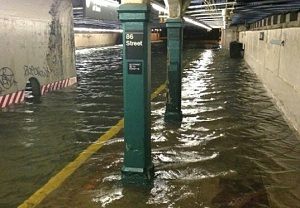Hurricane Sandy: a bellwether for infrastructure investment

The storm surge threat to the New York subway system was understood but widely ignored by the public.
Hurricane Sandy has given the United States a valuable lesson in why investing in public infrastructure is important. The devastation that Hurricane Sandy wrought on New York City’s transportation system was widely expected and also preventable. But prevention requires renewed political will and leadership.
Flooding from Hurricane Sandy has left tens of thousands of people in Manhattan without power; it could take weeks to restore the transit system. New York’s economy will suffer, and that effect will ripple though the United States. New York is one of its major economic engines, and that engine has ground to a near halt.
Officials engaged in some long term thinking about what to do to jumpstart the city after a hurricane, taking measures such as preemptively closing the subway system. That alone prevented further damage. Investments in weather satellites and other storm tracking technology also helped the city to prepare. It just wasn’t enough.
A storm like Sandy could cost the city as much as US$55 billion to fix its transportation system, and its 8.7 million weekday riders are left stranded and weary. Taxpayers will have to foot the bill to rebuild the system and harden it against future flooding. Wouldn’t it have made more sense to listen to the experts who saw this coming?
The storm surge threat was widely recognized. A series of hurricanes struck New York in 1938 and 1994; a water main caused severe flooding during the 1990s; other flooding events occurred in 2004 and 2007. There was even a near miss when Hurricane Irene struck the region a little over a year ago. Yet, nothing of consequence was done to mitigate the risks. New York’s Transit Authority continued to rely upon a fragile system of pumps - some even greater than a century old.
That’s right - the most densely populated city in the U.S. has been using secondhand pumps left over from the Panama Canal to drain its subway system on a daily basis. The entire subway system would flood if those pumps stopped for just two days. Much of lower Manhattan is made from landfill.
The city’s protections proved adequate in the past, but that was then. We live in a climate change world where 100-year extreme storms are the new normal, and so are the consequences - both for us and for coming generations. The question is, what are we going to do about it? Infrastructure is already woefully inadequate.
The American Society of Civil Engineers gives U.S. infrastructure a barely passing “D” grade, and that’s infrastructure that was built for a different time. New investment is needed, but will be challenging because the country is acutely politically-fragmented. Americans may be more willing to approve a new round of tax cuts than they are to be convinced that investing to build new things is important to do.
Further, what incentives exist for politicians to make those investments? A governor might be out of office before gaining the political benefit from a new bridge or tunnel, or the benefit might not be realized until a disaster happens. New York City failed to harden itself against the storm surge threat even while having a mayor who is outspoken in acknowledging the rising threat that climate change presents.
Public engagement would help, and so would long term investment programs such as an infrastructure bank. That is an idea worth debating. This should be an opportunity for us to do better in the future, but I wonder if America is still capable of having that dialogue. Has ideology trumped good governance?
You can return to the main Market News page, or press the Back button on your browser.

